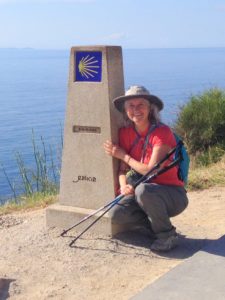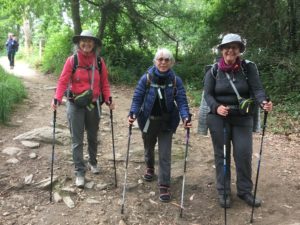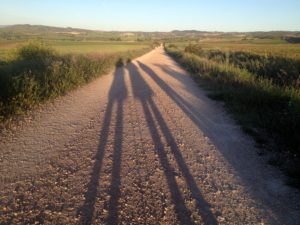
26 Apr Compostela Three Friends Walk the Way of the Stars (part two)
Maria is a massage therapist. Her true calling is that of offering massages to pilgrims, and only to pilgrims. She works in the Jacques de Molay hostel located in the small village of Terradillos. Chantal Lamothe, who was able to take advantage of Maria’s skills in treating her injured Achilles heel, explained that Maria has a unique view of the work she does.
“This woman, who I call the Guardian of the Camino, gives massages to those travelling on foot, explaining to them that they are experiencing their bodies in a completely new way. She says that she is there to soothe bodies subjected to constant movement.” Chantal learned much about the spirit of Compostela as she somehow managed to communicate with Maria in a mixture of broken Spanish and English.
Maria pointed out that some pilgrims choose to walk the Camino even though they are ill. Many who suffer from cancer hold out hope that the Camino will heal them. And it even happens that some die along the way. Maria wondered at the fact that many people undertake this adventure even though they are too advanced in age. And various pilgrims who were well aware of this fact confided to Maria that they saw this as being their last chance; that if they were to die on the road to Compostela they would consider themselves to have died in a state of grace!
Maria explained that our body is our vehicle, our home, and also our tool. “And indeed, Maria massaged us as if she were tuning a musical instrument.” The pilgrim does not simply endure his body, he is not satisfied with merely enduring it as best he can. No, he takes hold of it consciously with a view to experiencing the Camino to the fullest. By walking long distances, with a gentle gait, the pilgrim discovers a privileged, intimate relationship with his own body that also sheds light on its frailties.
The Wisdom of the Road
But Chantal went on to say that the real lesson she learned from Maria was something else. It resided in the wisdom this woman had gained through her contact with the hundreds and hundreds of pilgrims she had helped along their way. Maria acknowledges that there are four preconditions needed to ensure a successful pilgrimage: first, one must have the necessary time; second, it requires sufficient funds; thirdly, one must have the will to continue on day by day; and fourthly, and most importantly, it requires a commitment to activating one’s moral responsibility, to have a sense that one is treading the path for the sake of those who cannot do so.
Chantal went on to say that “Maria instilled in me an awareness of walking for something much greater than myself. It was as if I had been touched by a magic wand! I saw how this activity of transcending the self could be a healing experience. From that moment on, I dedicated my pains and sufferings to all those individuals who could not actively take on the journey. And that encouraged me to not give up!”
One of the rituals of the Camino was highly intriguing for our three lady pilgrims, and one they subjected themselves to: taking a picture of one’s shadow. Many “jacquets” (Compostela pilgrims) photograph their own shadow during the journey. “It is our companion, the mirror of what we are, a constant reminder that we are always in the company of our own selves. It gives us the feeling of being more complete while walking,” said Suzie Couture.
Chantal Lamothe pointed out something else the journey revealed. She referred to Rudolf Steiner’s indication that when discussing a conflict or problem at school with a child’s parents, it is a good idea to do so while walking, being in motion when trying to come to a decision concerning the child. She added that walking makes thinking more fluid, connecting the head with the feet and activating the rhythmic system. Thoughts find their rightful place, thinking becomes clearer.
Deciding to take on a quest like Compostela also means living with one’s own questions (“quest” and “question” have the same etymology). Chantal Lamothe explained this in the following way: “The fact that a physical journey corresponds to an inner path of development is something archetypal. Seeing a journey on foot as a means of self development seems rather naïve. But must we not look ahead of us if we are to move forward on the path of life?” Suzie Couture added that walking for an extended period of time activates circulation throughout our whole being – thinking, feeling, willing. “Can we not say that sickness is due to mental and physical circulation being blocked somehow?”
Arrival
After weeks of dealing with the elements, threating skies, fog, sun, wind and rain, they finally reached Compostela. Mission accomplished! How proud they were! But also, how disappointed not to be able to enter the cathedral to pray, since it was closed for renovations.
It was also a bit strange for them to realise that the journey had reached a successful conclusion after having spent so many days in the open air. Suzie Couture declared: “I observed the pilgrims gathered on the main square of this legendary site. Some greeted each other warmly. Others, bearing wounds, some with bandaged knees, seemed rather disoriented. I found myself thanking heaven for having successfully completed the journey. Yes, we made it!”

Suzie Couture in front of the kilometre zero marker, in Fisterra, on the shores of the Atlantic Ocean.
Suzie continued onwards to Fisterra, located at kilometre 0.0, which meant three more days’ walk to the shores of the Atlantic. “I was overcome with emotion. This was the final stage of the journey, but it was not the end. It was there that I knew that it is not the destination that counts, but rather the activity itself. This was the first time I had successfully completed such a large undertaking for my own sake, even though I had previously walked for the sake of others.” Yet Susie did feel “a bit blue, no longer being part of a group with other travelers.”
The “Après-Camino”
“What has begun to change after Compostela is the rhythm of my daily life. I am steadier now. The Camino never really ends, it is still with me. We have initiated a process which continues to live on,” said Chantal Lamothe. But then, after a few weeks, a kind of emptiness set in. “Little by little, happily, I am now beginning to experience moments of greater awareness. I appreciate how fortunate I was to be able to make the journey, the inner strength it gave me. They say that happiness is not at the end of the road, it is the road itself! Now, I find myself slowing down in order to process the multiple aspects of the experience.”
For Suzie Couture: “By taking time, you learn to fully be yourself. That is the lesson the Camino taught me. And I also have come back with a need to put my life in order, to decide what my true priorities are. The greatest gift the journey gave me was the ability to accept the place I find myself in now and to appreciate how far I have come up to this point. The experience of having journeyed on foot in all kinds of weather, wind, storms, rain, has led me to discover other aspects of my own self and to work on them.”
Suzie said she came home “feeling that as a mother and as a spouse I was more relaxed than ever.” And yet, she added, during the journey a certain question would often come to mind: “Beyond all these roles, who am I really? How do I want to organise my life from now on? I have the impression not of having reached a destination, but rather of having learned a new way of being, a new way of treading my life path. Movement stimulates circulation in all our bodies (physical, etheric, astral) and makes it possible for us to “visit” ourselves.
Manon Sévigny, who suffered from tendonitis due to fatigue, was able to take up her sports routine when she arrived back in Quebec. “Walking stabilises our inner being,” she insists. And whenever she picks up her backpack, memories of Compostela come flooding back.
The journey made her more aware of her body. “Since I am nearly 60, that was one of my goals.” However, she could not foresee that there would be pain involved. “My feet were terribly sore, but I felt good, because there was movement, life, and a sense of being one with nature. I was forced to recognise my limits and to accept them. Frustrated? Yes! Discouraged? No! I always found people who could help me. They were my Camino angels.” And what remains of the experience? “A greater confidence in myself and, above all, the ability to look more objectively at any event life brings my way. In short, a greater sense of equanimity.”
What’s more, it was the first time she had been away from her husband for an extended period of time. “We had missed each other, and that did us good! We discovered each other in a new light, and that also led me to see myself differently.”
Christ
Chantal Lamothe spoke of how she discovered that her Compostela experience had led to a deepening of her sense of Christianity. “I joined in stride with thousands of people who were all on their own personal quest. In former times, many pilgrims took on the journey in order to form a close connection with St. James, the apostle who walked with Christ. Today, it is by following our personal quest for the truth that we experience Christ within.”
She intends to continue cultivating in her daily life the state of being she experienced on the pilgrimage. “Ideally, I shall continue to make other, smaller “Camino journeys” in order to develop this awareness even further. When you’re far from home, living out of your backpack, it is easier to understand what is truly essential.”
In spite of a wounded tendon and a heart that was overworked on the climbs and through the difficult stretches, she said: “I always took it to be a trial that would make me inwardly stronger.” Chantal pointed out a detail that for her was a true “revelation of the Camino.” At the very end of the route, the pilgrim walks through a forest of eucalyptus trees. “The nut of that tree carries the mark of a cross or a star. I saw that as being a significant symbol.”
The Camino is a path of knowledge, a learning experience from beginning to end. This was how Manon Sévigny summed it up. “When I got home, I discovered that my garden had continued to grow without me – others had tended it in my absence. Being able to let go a bit is a good feeling!”
Moral Life
This then is the story of three friends who walked the Way of the Stars. They set off leaving behind all their normal activities. At first, they found it hard to overcome the inertia, to leave everything familiar, to break the circle of acquired habits without knowing if they would succeed in their undertaking or what was in store for them. But then came the experience of being in motion, surrounded by nature, with added cultural discoveries along the way. And finally came the inner transformation that experience brought about.
As for myself, I find it reassuring to see that in our crazy world, where everything is rushed, there are pilgrims who take the time to live at a human pace. They carry within them an image of the self in its becoming, seeking to go beyond themselves, as is stated in the ancient motto of the pilgrims of Compostela: Ultreïa! (beyond). They draw upon what the Medieval soul can best teach us in our time. We reflect on what we wrote in our pilgrim’s journals and especially what we feel rising up within us when we think back on our experience of the Camino, an indistinct sense of having for a time felt united. The beauty of the Camino is that it is never finished, it continues to live on in the soul.
The Camino has enriched the lives of thousands of people. On a personal level, it was there that I met the woman who would share my life for 22 years. It also creates social connections. For example, the Camino is responsible for the revitalisation of several rural regions in Spain and gave new life to villages that were on the verge of disappearing.
Nearly 25 years after having walked the Camino myself, and after doing the research for this article, I came across the following sentence by Kant, quoted by Rudolf Steiner: “There are two things that always cause amazement and respect to well up in our feeling: the starry heavens above me and the moral life within me.”*
This may seem strange, Rudolf Steiner explains, but “it is not astonishing in the least, since we are the external copy of the stars.” And in the same way, the Camino de Santiago can be seen to be the earthly replica of the Milky Way.
*Stuttgart, 17 February 1913. GA 140
Michel Dongois




Sorry, the comment form is closed at this time.